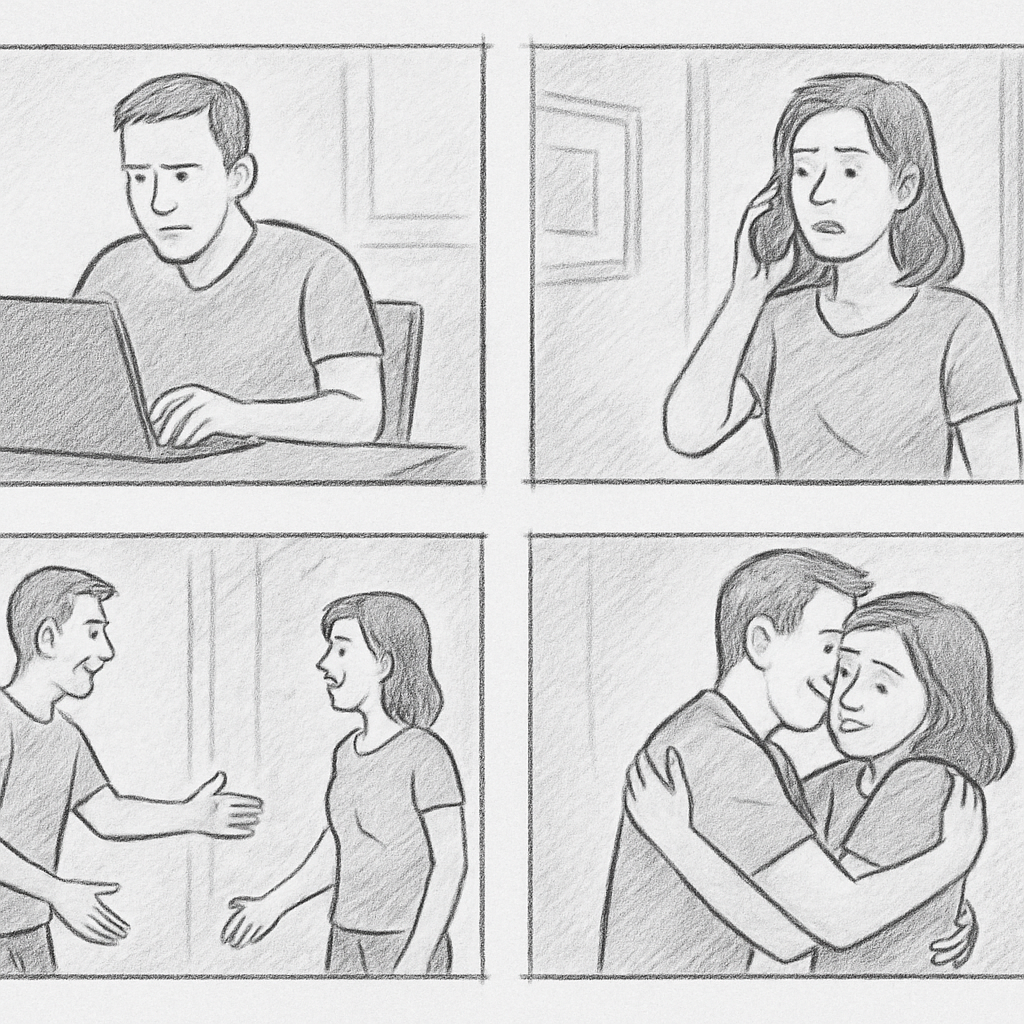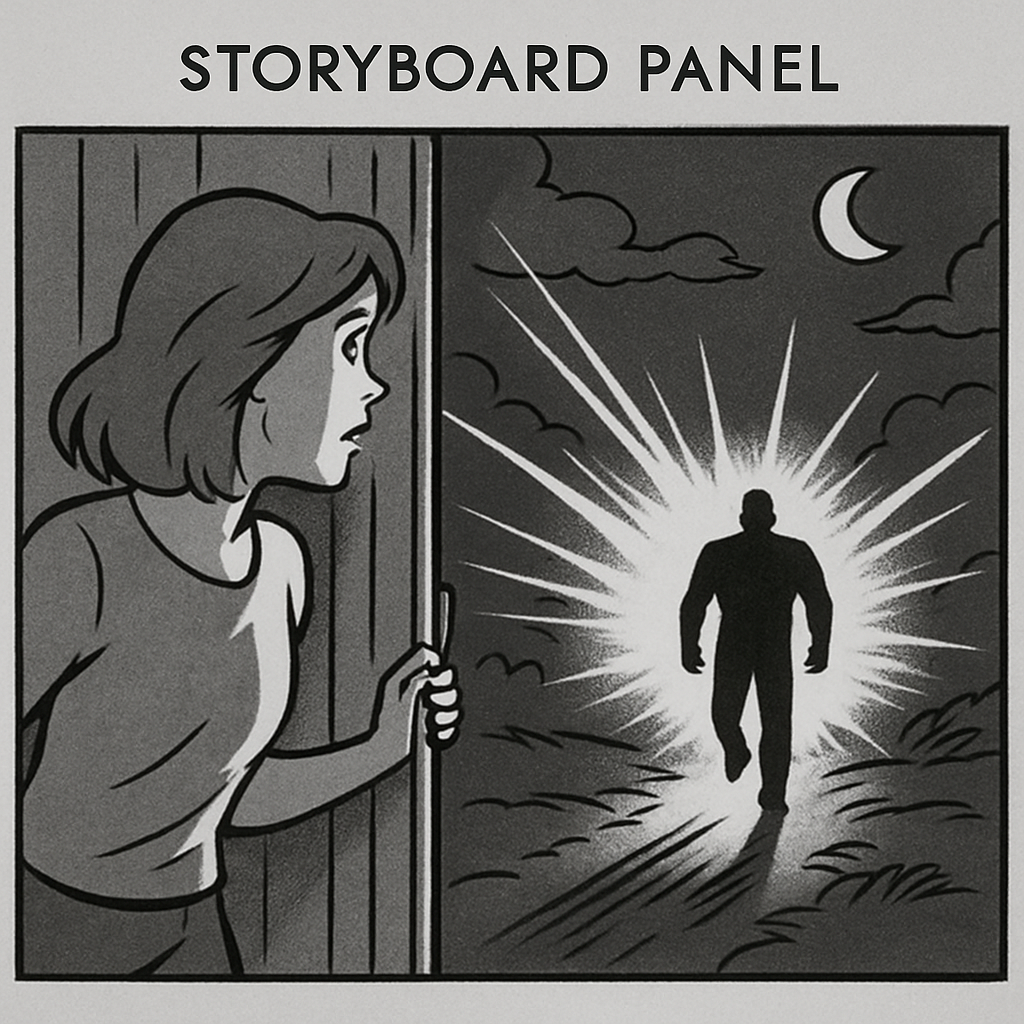Storyboarding is a vital part of film planning. It transforms ideas into visual sequences, guiding the filmmaking process.
A storyboard acts as a blueprint for your film. It helps in visualizing scenes, shots, and transitions.
Whether you’re creating a short film or a feature, storyboarding is essential. It ensures clarity and coherence in storytelling.
This guide will explore techniques to create effective storyboards. You’ll learn how to enhance your film’s narrative and visual style.
Discover how to storyboard for film with practical steps and storyboard examples.
What Is a Storyboard and Why Is It Essential for Film?
A storyboard is a sequence of drawings that represent the shots planned for a film. It outlines the flow of the movie, shot by shot.
Storyboards are crucial because they visually map out the script. This helps directors and crews understand the film’s narrative and visual style.
There are several reasons why storyboards are indispensable in filmmaking:
- They help in planning camera angles and movements
- They provide a visual framework for complex scenes
- They ensure the film’s narrative is cohesive
Storyboarding saves time and resources during production. It identifies potential challenges and solutions before filming begins. This fosters smoother collaboration among the crew members, aligning everyone with the director’s vision.
Key Elements of a Film Storyboard
A film storyboard is composed of various critical components. These elements ensure a clear and effective visual plan for your film.
A typical storyboard includes several key elements:
- Scene Number: Identifies the sequence of the scene.
- Shot Description: Details the visual action within the frame.
- Dialogue: Lists any characters’ spoken lines.
- Camera Movements: Describes movements like pan or zoom.
Each element plays a role in visual storytelling. They collectively ensure the plot and scenes are coherent and engaging. Understanding these components enhances communication with your crew, promoting a shared understanding of the film’s vision.
Step-by-Step Guide: How to Storyboard for Film
Creating a storyboard involves methodical steps that can turn your script into a detailed visual guide. This process helps to visualize sequences, anticipate shooting challenges, and streamline production.
Start by reading your script thoroughly. Understanding each scene’s essence is key to capturing the director’s vision correctly.
Break down the script into manageable pieces. Identify distinct sequences and how they connect to each other.
Once dissected, you can move on to selecting pivotal scenes. These scenes are often the ones that drive the narrative forward.
Now it’s time to sketch or create visual representations for each important shot. This step transforms written words into visual cues.
Don’t forget essential details such as dialogue, sound effects, and camera movements. These elements enhance the storyboard’s utility during filming.
A solid storyboard requires collaboration. Regularly discuss and modify it with your crew to refine the project.
Finally, review your storyboard to ensure it aligns with the overall vision. Revisions are an integral part of crafting an effective storyboard.

1. Break Down Your Script
Carefully dissect your script into segments. Look for key scenes and sequences that are crucial for the story.
Here’s how you can effectively break it down:
- Identify separate acts or sections.
- Highlight pivotal moments or climaxes.
- Note any recurring motifs or themes.
Segmenting allows for a deeper understanding of each scene’s role, ensuring a structured approach to visual storytelling.
Connecting these elements facilitates a coherent visual sequence, enhancing clarity for the production team.
2. Identify and Map Out Key Scenes
Key scenes are the backbone of your story. Finding these moments can shape how the narrative unfolds visually.
Consider how each significant event ties into the overarching plot. This approach solidifies the film’s structure.
Map out these scenes on paper or digitally. Arrange them in a sequence that naturally follows the script’s progression.

Visualize how each scene transitions into the next. A smooth narrative flow can make the storyboard more intuitive.
3. Sketch or Create Visuals for Each Shot
Transform your script into clear visuals. You don’t need to be an artist; simple sketches can suffice.
Focus on framing, composition, and major actions in each shot. This will guide the camera work effectively.
Experiment with various styles to find what best matches the film’s tone. Adapt to genres or moods as necessary.

Clear visuals can convey powerful emotions and build deeper connections with viewers, enriching the storytelling process.
4. Add Descriptions, Dialogue, and Camera Directions
Enrich each storyboard panel with crucial details. These additions will be invaluable during the shoot.
Key elements to include are:
- Brief descriptions of actions.
- Dialogue snippets or key lines.
- Camera angles and movement descriptions.
Adding these elements gives crew members clear instructions. It also ensures that everyone shares the same understanding of each scene’s dynamics.
These annotations can be revisited and adjusted as necessary, maintaining the project’s flexibility.
5. Review, Revise, and Collaborate
Completing the storyboard is just the beginning. Collaboration is crucial for refining the final product.
Schedule a session with your team to discuss any improvements. Their input can uncover overlooked aspects.
Review your storyboard frequently. Flexibility allows for creative changes and improvement over time.
By embracing collaboration, you ensure the storyboard effectively captures the film’s essence, optimizing storytelling efficiency.
Digital vs. Hand-Drawn Storyboards: Tools and Techniques
Choosing between digital and hand-drawn storyboards is a crucial decision for filmmakers. Both methods offer unique benefits, suited to different needs and preferences.
Hand-drawn storyboards provide a personal touch. Many find the tactile process inspiring and more intuitive. A simple sketchbook and pencils can suffice, making this method budget-friendly.
Digital storyboards, on the other hand, offer precision and flexibility. Software like Adobe Illustrator or Storyboard That provides tools to create detailed, editable frames.
Consider the following when choosing your storyboard approach:
- Ease of collaboration and sharing.
- Time available for creation and revisions.
- Budget for materials or software.

Digital formats facilitate collaboration, as they can be shared easily online. It’s ideal for projects involving remote teams.

Ultimately, the choice between digital and hand-drawn depends on personal preference and project needs. Both methods can effectively visualize the film’s vision.
Storyboarding Tips for Short Films and Features
Crafting a storyboard for different lengths of films requires a nuanced approach. Short films demand a concise and economical visual plan. Every frame should drive the story forward, leaving no room for filler.
For feature films, your storyboard can afford more detail and exploration. You have the latitude to delve into subplots and elaborate visuals. Remember, however, that maintaining a coherent narrative is key, regardless of length.
Consider these tips when storyboarding:
- Prioritize key scenes and moments.
- Ensure clarity and flow of the narrative.
- Optimize for flexibility in execution.

Adapt your process to fit the film’s length and complexity. This approach ensures a streamlined and effective storytelling journey on the screen.
Storyboard Examples from Iconic Films
Studying storyboards from notable films can provide valuable insights. These examples often reveal the creative process behind cinematic masterpieces. They show how visionary directors translate scripts into compelling visual narratives.
For example, the storyboards from Alfred Hitchcock’s films showcase his mastery in suspense. Each frame meticulously aligns with the film’s psychological tension. Similarly, the detailed storyboards from “Star Wars” highlight dynamic scenes and imaginative worlds.
Consider the following iconic examples:
- Alfred Hitchcock’s “Psycho”
- George Lucas’s “Star Wars”
- Ridley Scott’s “Blade Runner”


These examples underscore the storyboard’s role in a film’s visual strategy. Examining them can inspire filmmakers to elevate their storyboarding skills.
Common Mistakes to Avoid When Storyboarding
Mistakes in storyboarding can hamper the filmmaking process. One frequent error is neglecting detail, which may lead to confusion during production. Another common issue is failing to include clear visual or textual information.
It’s crucial to avoid these pitfalls:
- Skipping key scenes
- Omitting camera directions
- Overlooking continuity
Efficient storyboards should provide a clear roadmap for the crew. They should communicate the vision precisely to avoid misinterpretation. Paying attention to these common mistakes ensures smoother filming and enhanced collaboration among team members.
How to Use Your Storyboard During Production
Storyboards are vital tools throughout production, keeping the team aligned. During filming, refer to your storyboard to guide each scene’s setup. It helps in ensuring the production stays true to the original vision.
Key uses include:
- Checking scene composition
- Planning camera angles
- Reviewing dialogue
A well-referenced storyboard minimizes communication gaps between departments. It ensures everyone understands the scene’s requirements, from props to actor positioning. By utilizing your storyboard effectively, the shoot becomes more efficient and collaborative.

Conclusion: Mastering Storyboarding for Effective Film Planning
Storyboarding is crucial for successful film planning and execution. A well-crafted storyboard clarifies your vision and guides the crew. It ensures everyone works towards the same goal, reducing errors and boosting creativity.
By mastering storyboarding techniques, filmmakers can enhance storytelling and improve the quality of their films. Embrace storyboarding as a vital part of your filmmaking process for efficient production and dynamic visuals.

